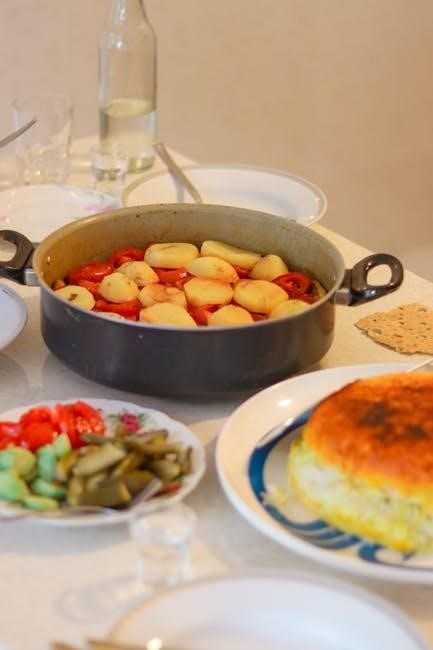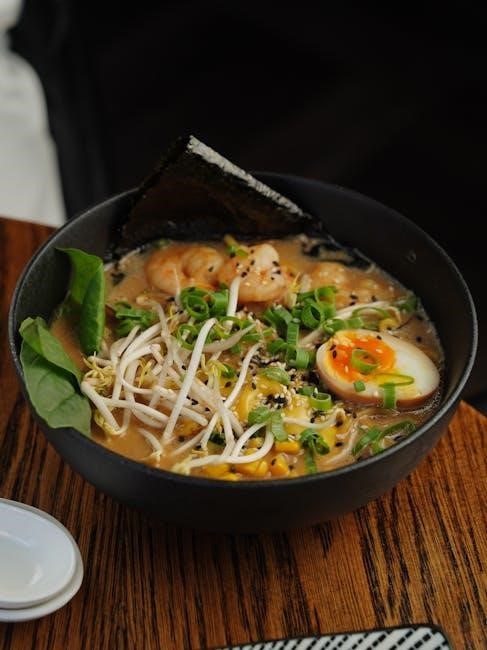sod cooking guide

Sod cooking is a unique culinary practice involving the use of sod or grass in preparing meals, offering a natural and earthy flavor profile. It allows chefs to connect with nature while exploring innovative gastronomic possibilities, making it a fascinating and sustainable cooking method for adventurous food enthusiasts;
1.1. What is Sod Cooking?
Sod cooking is a distinctive culinary method that incorporates sod or grass into meal preparation, offering a unique, earthy flavor. It involves using sod as an ingredient or cooking medium, blending natural elements with gastronomy. This practice allows chefs to explore innovative dishes while connecting with nature. Sod cooking is versatile, suitable for various cuisines, from savory dishes to creative desserts. Its adaptability makes it appealing to eco-conscious cooks and adventurous food enthusiasts seeking sustainable and flavorful meals. This method highlights the potential of integrating natural materials into modern culinary arts, fostering creativity and environmental harmony.
1.2. Benefits of Sod Cooking
Sod cooking offers a unique, earthy flavor and a sustainable way to prepare meals. It enhances dishes with natural, mineral-rich ingredients, promoting a healthier dining experience. This method reduces reliance on processed foods and fosters creativity in the kitchen. Sod cooking also supports eco-friendly practices by utilizing readily available natural resources. Its versatility allows chefs to experiment with various cuisines, from traditional to modern recipes. Additionally, sod cooking encourages a deeper connection with nature, making it a fulfilling and innovative culinary practice for health-conscious food enthusiasts.
1.3. Brief History of Sod Cooking
Sod cooking traces its roots to ancient times, where early cultures utilized natural resources for culinary purposes. Indigenous communities often cooked meals wrapped in animal hides or sod-lined pits, infusing earthy flavors into their food. This method, born out of necessity, became a cherished tradition, reflecting a deep connection with nature. Over time, sod cooking evolved, adapting to modern techniques while retaining its primal essence. Today, it is celebrated for its sustainability and unique flavor profiles, bridging the gap between ancestral practices and contemporary gastronomy.
Essential Tools for Sod Cooking
Kitchen knife, cooking tongs, heat-resistant gloves, shovel, cooking pit or grill, and a thermometer are must-have tools for preparing and managing sod cooking effectively.
2.1. Must-Have Equipment
For sod cooking, essential tools include a shovel for digging and handling sod, heat-resistant gloves for safety, and a cooking pit or grill to manage heat evenly; A kitchen knife and cutting board are necessary for preparing sod and ingredients. Additionally, tongs or a spatula help in turning and removing cooked sod from the heat source. A thermometer ensures optimal cooking temperatures, while fireproof containers or foil can be used for steaming sod. These tools are fundamental for a safe and effective sod cooking experience.
2.2. Optional but Helpful Gadgets
While not essential, certain gadgets can enhance your sod cooking experience. A food processor can finely chop sod for even cooking, while a sod infuser helps distribute flavors evenly. A smoker box adds a smoky taste, and a blender can mix sod with other ingredients seamlessly. Additionally, a dehydrator can dry sod for storage or create crispy textures. These gadgets offer convenience and versatility, allowing you to experiment with sod cooking in creative and efficient ways. They are ideal for those looking to elevate their sod-based dishes beyond basic recipes.
Common Ingredients in Sod Cooking
Sod, or grass, is the primary ingredient, often paired with herbs, spices, and vegetables. Companion ingredients like garlic, olive oil, and lemon enhance flavor profiles, creating balanced dishes.
3.1. Types of Sod or Grass Used
Various types of sod and grass are utilized in sod cooking, each offering unique textures and flavors. Common choices include wheatgrass for its mild taste, lemongrass for a citrusy note, and ryegrass for its earthy undertones. Some cooks also experiment with wild grasses like buffalo grass or blue grama, which add distinct regional characteristics to dishes. The selection often depends on availability and desired flavor profiles, allowing cooks to diversify their recipes creatively.

3.2. Companion Ingredients for Enhanced Flavor
Companion ingredients play a crucial role in elevating sod-based dishes, adding depth and complexity. Herbs like parsley, dill, and basil bring freshness, while spices such as cumin and coriander add warmth. Citrus elements, like lemon zest or orange peel, introduce brightness, balancing the earthiness of sod. Natural sweeteners like honey or maple syrup can counteract bitter notes, creating harmony. These ingredients not only enhance flavor but also complement the unique texture of sod, making each dish more vibrant and appealing to the palate.

Basic Techniques in Sod Cooking
Mastering sod cooking involves learning foundational techniques like steaming, roasting, and infusing flavors. These methods ensure sod is cooked evenly while preserving its natural essence and nutrients.
4.1. Preparing Sod for Cooking
Preparing sod for cooking involves selecting fresh, clean grass or sod, rinsing it thoroughly, and patting it dry to remove excess moisture. For optimal flavor, choose sod free of pesticides or chemicals. If using sod in dishes, chop it finely or blend it into mixtures for even distribution. Proper preparation ensures the sod integrates seamlessly into recipes, enhancing both texture and taste while maintaining its natural nutrients and earthy aroma.
4.2. Mixing and Blending Techniques
Mixing and blending sod into recipes requires careful techniques to ensure even distribution and optimal flavor. Start by finely chopping the sod and incorporating it gradually into your base ingredients. For smooth textures, blend sod with liquids or soft elements like yogurt or herbs. When layering sod in dishes, fold it gently to maintain its delicate structure. Experiment with ratios to balance earthy and vibrant flavors, allowing the sod to complement rather than overpower other components. This method enhances both visual appeal and taste, making sod a versatile culinary addition.

Step-by-Step Sod Cooking Guide
Discover how to prepare sod-based dishes with detailed instructions, ensuring safety and creativity. Follow recipes, from simple to advanced, for a flavorful and unique culinary experience.
5.1. Starting with Simple Recipes
Embark on your sod cooking journey with straightforward recipes that blend sod with familiar ingredients. Begin with sod-infused teas or salads, gradually experimenting with more complex dishes. These simple recipes allow you to acquaint yourself with sod’s earthy flavor without overwhelming your palate. Start by infusing sod into teas for a subtle herbal taste or add it to salads for a fresh twist. As you gain confidence, explore soups and sauces, using sod to enhance umami flavors. Remember to pair sod with complementary herbs like mint or basil for a balanced taste. This approach ensures a smooth transition into the world of sod cooking, making it enjoyable and approachable for newcomers.
5.2. Advanced Methods for Experienced Cooks
Experienced cooks can elevate sod cooking by exploring sophisticated techniques such as sod-smoked meats or sod-infused fermentation. For instance, smoking brisket over sod adds a unique earthy flavor, while fermenting sod with herbs creates a tangy marinade. Pairing sod with luxury ingredients like truffle oil or caviar can refine dishes, offering a gourmet twist. Advanced methods also include sod-based sauces for molecular gastronomy or crafting sod-infused oils for drizzling. These techniques challenge culinary boundaries, enabling chefs to innovate and redefine modern cuisine with sod as a central ingredient.

Cultural and Traditional Aspects
Sod cooking reflects diverse cultural practices, with traditions varying globally. It symbolizes a connection to nature and heritage, offering unique regional flavors and culinary storytelling.
6.1. Sod Cooking in Different Cultures
Sod cooking varies across cultures, with unique techniques reflecting local traditions. In some regions, sod is used to wrap food for earthy flavors, while others blend it into sauces. Indigenous communities often incorporate sod for its nutritional value, showcasing its versatility. This practice highlights a deep connection to nature and cultural heritage, emphasizing sustainability and resourcefulness. By exploring sod cooking globally, one discovers diverse culinary expressions that celebrate local ingredients and traditions, offering a fascinating glimpse into how cultures adapt natural elements into their cuisine.
6.2. Traditional Recipes and Their Significance

Traditional sod cooking recipes often hold deep cultural and historical significance, passed down through generations. These dishes, such as sod-wrapped fish or grass-infused stews, showcase the resourcefulness of ancestors. They highlight the importance of using locally available ingredients and preserving culinary heritage. Many recipes are prepared during festivals or special occasions, symbolizing community bonding and respect for nature. By cooking these meals, people honor their roots and keep traditional practices alive, ensuring their cultural legacy endures for future generations to appreciate and enjoy.
Tips for Beginners
Start by selecting fresh, clean sod and thoroughly rinsing it before use. Begin with simple recipes to build confidence and gradually experiment with new techniques. Patience is key to mastering sod cooking, as it requires time to develop the right flavors and textures. Always prioritize safety and hygiene to ensure a enjoyable cooking experience.
7.1. Common Mistakes to Avoid
One of the most common mistakes beginners make in sod cooking is using sod that hasn’t been properly cleaned or rinsed, which can lead to gritty textures or unwanted flavors. Overmixing sod with other ingredients can also result in a loss of its natural essence. Additionally, cooking sod at too high a heat can cause it to become brittle or lose its vibrant color. It’s important to avoid these pitfalls to ensure a delicious and visually appealing dish. Always remember, patience and attention to detail are crucial in perfecting sod cooking techniques. By being mindful of these common errors, you can elevate your cooking and enjoy the full benefits of incorporating sod into your meals.
7.2. Tricks for Perfecting Your Technique
To master sod cooking, start by using fresh, organic sod for the best flavor and texture. Lightly toast sod in a dry pan before incorporating it into dishes to enhance its earthy aroma. Pair sod with complementary flavors like herbs or citrus to balance its bitterness. Experiment with different cooking times to achieve the perfect consistency. Don’t be afraid to try new combinations—sod pairs surprisingly well with sweet ingredients like honey or berries. Practice makes perfect, so keep experimenting to refine your skills and unlock the full potential of sod in your culinary creations.

Health Considerations
Sod cooking emphasizes safety and nutrition. Ensure sod is free of pesticides and contaminants for safe consumption. It provides essential vitamins and minerals, enhancing overall well-being naturally.
8.1. Safety Precautions

When practicing sod cooking, ensure the sod or grass used is free of pesticides, heavy metals, and contaminants. Always source sod from clean, organic environments to avoid health risks. Wash the sod thoroughly before cooking to remove dirt and potential pollutants. Individuals with allergies or sensitive digestion should approach sod consumption cautiously, as it may cause adverse reactions. Proper preparation and hygiene are crucial to safely enjoy the benefits of sod cooking. Consulting a healthcare professional before adopting sod as a dietary component is recommended to address personal health concerns.
8.2. Nutritional Benefits of Sod Cooking
Sod cooking offers several nutritional benefits, as sod contains essential minerals like iron, calcium, and magnesium, as well as vitamins C and K. It is rich in antioxidants, which help protect the body from oxidative stress. The fiber content in sod supports healthy digestion and can aid in maintaining balanced blood sugar levels. Additionally, sod is low in calories and gluten-free, making it a suitable option for those with dietary restrictions. Incorporating sod into meals can enhance overall nutrient intake and promote a more sustainable, earth-connected diet.

Recipe Variations
Sod cooking offers diverse recipe variations, from savory dishes to sweet desserts, allowing chefs to experiment with unique flavors and textures, enhancing culinary creativity and exploration.
9.1. Vegetarian and Vegan Options
Vegetarian and vegan options in sod cooking are plentiful, offering innovative ways to incorporate plant-based ingredients. Sod can be blended with herbs, mushrooms, and legumes to create hearty, flavorful dishes. For vegans, plant-based proteins like tofu or tempeh can be infused with sod for a unique texture. Desserts can feature sod mixed with fruits or dark chocolate, providing a rich, earthy taste. These recipes cater to diverse dietary preferences while maintaining the distinctive sod flavor, making them ideal for health-conscious and environmentally aware cooks seeking creative meal solutions.
9.2. Incorporating Sod into Desserts
Incorporating sod into desserts adds a unique, earthy flavor to sweet treats. Sod can be blended with dark chocolate for a rich, mocha-like taste or mixed with fruits like berries or citrus for a refreshing twist. It pairs well with creamy textures, such as in sod-infused ice cream or puddings. For a creative touch, sod can be sprinkled as a garnish or used to make sod-based sauces. These innovative dessert ideas allow for experimentation, blending nature with sweetness to create memorable and distinctive dishes perfect for adventurous food lovers.
Sod cooking offers a creative and earthy culinary experience, blending natural flavors with traditional recipes. It encourages experimentation and sustainability, inspiring chefs to explore new gastronomic possibilities while connecting with nature.
10.1. Final Thoughts on Sod Cooking
Sod cooking is a unique culinary journey that challenges traditional methods while fostering creativity and a deep connection to nature. It encourages chefs to think outside the box, embracing the earthy flavors and textures that sod and grasses provide. This practice not only highlights sustainability but also offers a refreshing perspective on gastronomy. By experimenting with sod, cooks can unlock new dimensions of taste and presentation, making each dish a testament to their innovation and skill.
Ultimately, sod cooking is more than a trend—it’s a celebration of nature’s bounty and human ingenuity, inviting everyone to explore and savor the unexpected.
10.2. Encouragement to Experiment

Embrace the creativity that sod cooking offers and don’t hesitate to try new recipes. Experimenting with sod allows you to discover unique flavors and textures, making every dish a exciting journey. Start with simple recipes and gradually explore more complex ones, tweaking ingredients to suit your taste. Remember, every challenge is an opportunity to learn and innovate. Don’t be afraid to push boundaries—sod cooking is all about exploration and creativity. Share your experiences and inspire others to join you in this culinary adventure!
References and Further Reading
Explore recommended cookbooks like The Art of Sod Cuisine and online forums such as SodCookingCommunity.com for in-depth guides, tips, and inspiration to enhance your sod cooking journey.
11.1. Recommended Cookbooks
For a deeper dive into sod cooking, explore cookbooks like The Sod Chef and Earthly Flavors: A Guide to Sod Cuisine; These books offer recipes, techniques, and insights into incorporating sod into meals. Sustainable Cooking with Grass provides eco-friendly approaches, while Global Sod Recipes highlights international dishes. The Art of Wild Ingredients is perfect for foraging enthusiasts. These resources will enhance your understanding and inspire creativity in the kitchen, ensuring a well-rounded approach to sod cooking.
11.2. Online Resources
For further exploration, visit websites like SodCookingForum.com and GreenCulinary.com, which offer detailed guides and forums for sod cooking enthusiasts. YouTube channels such as SodCulinaryArts provide video tutorials and recipe demonstrations. Additionally, blogs like TheSodKitchen share innovative recipes and tips. The University of Horticulture website offers safety guidelines and research on edible grasses. Join the Sod Cooking Enthusiasts Facebook group for community support and recipe exchanges. These resources will help you deepen your knowledge and refine your sod cooking skills.